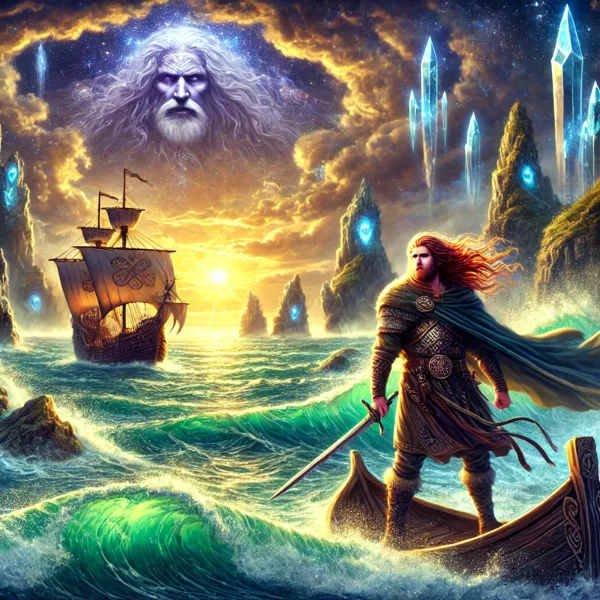The Voyage of Mael Dúin
Ireland’s mythology is filled with tales of warriors, gods, and magical journeys, but few stories capture the imagination quite like The Voyage of Mael Dúin. This immram (voyage tale) is a legendary sea adventure that blends myth, morality, and the supernatural, taking Mael Dúin and his crew on an epic journey across enchanted waters. It is a tale of fate, vengeance, and forgiveness, making it one of the most thought-provoking myths in Irish storytelling.
Table of Contents
Who Was Mael Dúin?

Mael Dúin was the son of a warrior and a nun, raised without knowing the truth about his father. When he finally discovers that raiders murdered his father, he is consumed by the need for vengeance. Determined to seek justice, Mael Dúin gathers a crew, builds a ship, and sets sail to find and kill those responsible for his father’s death. However, fate has other plans, and his journey takes an unexpected and mystical turn.
The Journey Begins – Fate Intervenes
As Mael Dúin and his men set off on their quest for vengeance, a supernatural storm suddenly arises and blows them off course. Unable to return to their intended path, they are forced to sail into the unknown, encountering a series of strange and magical islands. These islands test their patience, wisdom, and morality, gradually shifting their journey’s purpose from revenge to self-discovery and enlightenment.
The Strange and Supernatural Islands
Mael Dúin and his crew encounter numerous islands throughout their travels, each presenting a unique challenge or lesson. Some of the most fascinating include:
- The Island of the Giant Ants – A terrifying land where enormous, man-eating ants force the crew to flee. This warns against greed and recklessness.
- The Island of the Laughing People – Inhabitants do nothing but laugh eternally, creating an eerie atmosphere. Is it joy, madness, or a curse? The crew cannot tell.
- The Island of the Magic Apples – A tree bearing eternally fresh apples provides endless sustenance, symbolising temptation and abundance.
- The Island of the Glass Bridge – A mysterious bridge that only those pure of heart can cross, testing the morality of Mael Dúin and his men.
- The Island of the Woman and the Silver Net – A supernatural woman attempts to ensnare the crew, showing the power of illusion and desire.
Each island offers a different mystical trial, gradually leading Mael Dúin away from vengeance and towards a greater understanding of his own destiny.
The Turning Point – A Change in Heart
After years of wandering, Mael Dúin finally reaches the island where his father’s killers reside. However, by this point, his journey has profoundly changed him. The trials he faced and the wisdom he gained made him realise that revenge would not bring peace. Instead of killing his enemies, he chooses forgiveness. This decision marks a turning point in his character and Irish mythology, where warriors were often bound to cycles of vengeance and retribution.
Themes and Symbolism in The Voyage of Mael Dúin
- Fate vs. Free Will – Though Mael Dúin sought vengeance, fate pushed him towards wisdom and redemption.
- Christian and Pagan Influences – The tale blends Celtic Otherworldly themes with Christian morality, particularly in its emphasis on forgiveness.
- The Hero’s Journey – Similar to Odysseus, Mael Dúin undergoes a transformation, shifting from a warrior seeking revenge to a man of wisdom.
- Symbolic Islands – Each island serves as a test of virtue, patience, or morality, shaping Mael Dúin’s final decision.
The Influence of Mael Dúin’s Voyage
The Voyage of Mael Dúin is one of the earliest examples of Irish immrama (voyage tales) and inspired later works, including The Voyage of Saint Brendan. It reflects a time when Ireland was transitioning between its pagan traditions and its Christian beliefs, blending the two into an unforgettable myth.
Conclusion
The story of Mael Dúin is more than just a mythical adventure; it is a lesson in growth, forgiveness, and the power of fate. His transformation from a man seeking vengeance to one who chooses mercy makes this tale stand out in Irish mythology.
Would you have made the same choice as Mael Dúin, or would revenge have been too strong to resist? Let us know your thoughts in the comments!
This legend reminds us that the greatest journeys are not about reaching a destination but about discovering who we truly are.
Source: Immram Maíle Dúin, an Irish tale written in the 8th century and preserved in manuscripts such as The Book of the Dun Cow and The Yellow Book of Lecan.
Recommended Articles:
- Tír na nÓg – The Land of Eternal Youth in Irish Mythology
- The Story of Fionn mac Cumhaill – Ireland’s Greatest Warrior
- Hy-Brasil – The Mysterious Vanishing Island of Ireland
Recommended Books:
- Translations of the Táin Bó Cúailnge
- The Story of Ireland by Neil Hegarty
- Early Irish Myths and Sagas by Jeffrey Gantz
- A New History of Ireland: Prehistoric and Early Ireland, edited by Dáibhí Ó Cróinín
